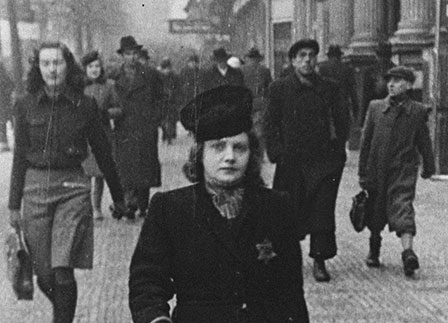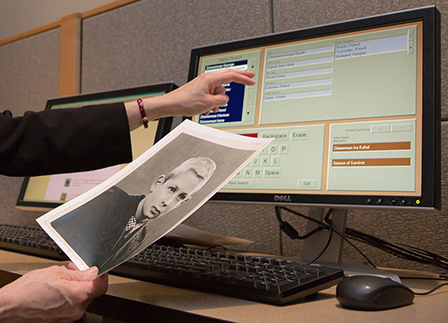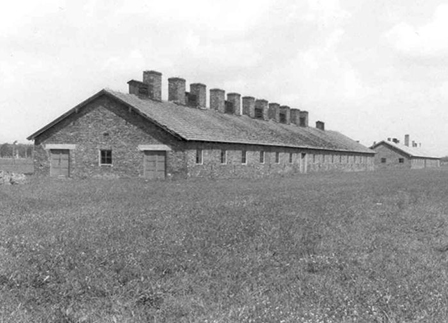Overview
- Brief Narrative
- Anti-Jewish poster issued in German occupied Serbia in the fall of 1941 for the Grand Anti-Masonic Exhibition in Belgrade from October 22, 1941, to January 19, 1942. It depicts a grotesque caricature of an oversized Jewish man pulling a rope around the necks of six men in business clothes to show the ways Jews manipulate financial markets and have a stranglehold on business. The exhibit focused on the alleged Jewish-Communist-Masonic conspiracy to achieve world domination with the intent to increase hatred against outsider groups that opposed Nazi Germany. Yugoslavia had been invaded and dismembered by the Axis powers in April 1941. Germany annexed most of Slovenia and placed Serbia under military occupation. The exhibition was organized by the Serbian puppet government in collaboration with the German occupiers.
- Artwork Title
- You have no idea... Be alert!
- Series Title
- Grand Anti-Masonic Exhibition
- Date
-
publication/distribution:
1941
- Geography
-
distribution:
Grand Anti-Masonic Exhibition;
Belgrade (Serbia)
- Credit Line
- United States Holocaust Memorial Museum Collection, The Abraham and Ruth Goldfarb Family Acquisition Fund
- Markings
- front, top right, black ink : Serbian text [You have no idea..] or [You don't know yet...]
front, bottom center, red outlined in black ink : Serbian text [Be alert!]
front, lower left corner, black ink : Pr. Bg. L/9/4/149/x5
Physical Details
- Language
- Serbian
- Classification
-
Posters
- Category
-
Anti-Jewish propaganda
- Object Type
-
Posters, Serbian (lcsh)
- Physical Description
- Poster on offwhite paper with a gradient red background. Filling the upper half is a caricature of an oversized man wearing a long, black coat and a skull cap with a Star of David. He is scowling and his nose is disproportionately large for his already exaggerated stereotyped Jewish features. His skin is whitish, and he has a long pointed beard and peyot [side curls], with large ears, thick eyebrows, and an open mouth with 2 teeth. He grips in both hands a thick yellow rope with a slip knot around the necks of a group of 6 men half his size in business clothes. The men are agonized, choked, and pulled off the ground by the thick rope around their necks; their faces are pink, some have open mouths with protruding tongues, and splayed limbs. There is Serbian cursive text above and on the left, and across the lower edge.
- Dimensions
- overall: Height: 27.375 inches (69.533 cm) | Width: 19.125 inches (48.578 cm)
- Materials
- overall : paper, ink, adhesive
Rights & Restrictions
- Conditions on Access
- No restrictions on access
- Conditions on Use
- No restrictions on use
Keywords & Subjects
Administrative Notes
- Legal Status
- Permanent Collection
- Provenance
- The antisemitic poster was acquired by the United States Holocaust Memorial Museum in 2007.
- Funding Note
- The acquisition of this collection was made possible by The Abraham and Ruth Goldfarb Family Acquisition Fund.
- Record last modified:
- 2024-10-03 10:54:03
- This page:
- http://collections.ushmm.org/search/catalog/irn519148
Download & Licensing
In-Person Research
- By Appointment
- Request 21 Days in Advance of Visit
- Plan a Research Visit
- Request to See This Object
Contact Us
Also in World War II antisemitic and anti-Nazi poster collection
The collection consists of four posters, two Serbian antisemitic posters, one Nuremberg Trial poster, and one Polish film poster, that are relevant to the history of the Holocaust.
Date: 1941-1983
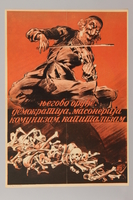
Poster of a caricatured Jewish man fiddling and dancing on human bones
Object
Anti-Jewish poster issued in German occupied Serbia in the fall of 1941 for the Grand Anti-Masonic Exhibition in Belgrade from October 22, 1941, to January 19, 1942. It depicts a grotesquely caricatured Jewish man dancing ecstatically on a huge pile of broken skeletons while playing a violin, his weapon for spreading lies. The exhibit focused on the alleged Jewish-Communist-Masonic conspiracy to achieve world domination. Jews were portrayed as the source of all evil, which had to be destroyed, along with Jewish controlled countries, such as the Soviet Union and the US, and any outsider groups that opposed Nazi Germany. Yugoslavia was invaded and dismembered by the Axis powers in April 1941. Germany annexed most of Slovenia and placed Serbia under military occupation. The exhibition was organized by the Serbian puppet government of Milan Nedic in collaboration with the German occupiers.
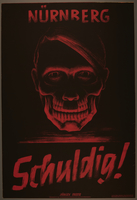
Nuremberg war crimes trial poster proclaiming guilty with Hitler as a grinning skull
Object
Poster created by Jurgen Freese for the Nuremberg Trials in 1946. The poster depicts the head of Hitler as a skull. After the end of the war and the defeat of Nazi Germany, Allied occupation authorities in Germany used posters such as this one to emphasize the criminal nature of the Nazi regime. An International Military Tribunal (IMT) was convened at Nuremberg, Germany, soon after the end of World War II on May 7, 1945. It purpose was to seek justice for crimes against humanity, evidenced by the Holocaust, perpetrated by Nazi Germany. In October 1945, the IMT formally indicted the Nuremberg defendants on four counts: crimes against peace, war crimes, crimes against humanity, and conspiracy to commit these crimes; the verdicts were delivered on October 1, 1946.
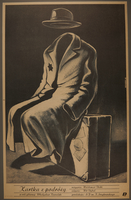
Poster for a postwar Polish film
Object
Poster advertising the Polish film, Travel Card, from 1984. The film was based on the novel, “Mr. Theodore Mudstock” by Ladislav Fuks, in which a middle-aged Jewish man, Jakub Rosenberg, prepares himself to be deported to a concentration camp.

